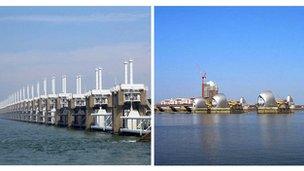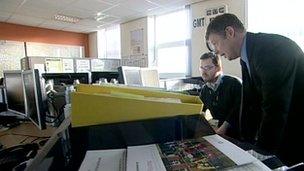1953 flood: How UK defences compare with the Netherlands
- Published

The North Sea floods of 1953 killed more than 1,800 people in the Netherlands
The North Sea floods of 1953 claimed 307 British lives. In the Netherlands, the dead numbered more than 1,800.
Since then, the Netherlands has developed some of the best flood defences in the world while experts believe parts of the UK coastline remain vulnerable.
The total spend on defences on the east coast in Lincolnshire, Norfolk, Suffolk and Essex was £250m in 10 years.
In the Netherlands, 0.1% of the entire gross domestic product - between 500 and 600m euros (£420m to £513m) - is spent on a network of sluices, locks and barriers.
The job of improving those defences - by making them bigger, using newer technology, widening rivers and building floating homes - is ongoing.

The Dutch Oosterscheldekering (left) and the Thames Barrier (right)
The Dutch approach has been possible through taxation and a cultural commitment to flood defences as a communal responsibility.
Peter Glas, the president of the Dutch Association of Regional Water Authorities, said people in the Netherlands treated flood defence as a "collective" responsibility and rarely flinched at the idea it costs each person a few hundred euros each year.
"I think it goes back to the (1953) disaster," he said.
"There was a national feeling of "never again" and that we should safeguard our nation and population from such threats from the sea and rivers.
"That has been translated into these very high standards of defences."
'Imperfect, but pragmatic'
Asked whether he felt the Netherlands was better prepared for a similar surge, Mr Glas said: "It is not for me to say.
"But I think they (the British authorities) should be aware of the problems and the threat.
"The Netherlands has a standard which should safeguard our land from the kind of storms you can expect in one in 10,000 years."
The level of protection offered by the Dutch defences is far higher than in the UK.
Even London, the best protected site in the country, pales in comparison with the level of defences built in the Netherlands.
The UK capital's defences - which includes the Thames Barrier - are equipped for a one in 1,000-year flood or surge event.
Experts in the UK say the British approach has not been about building the best available defences, but balancing risk and cost.
Professor Ian Cluckie, pro-vice chancellor at Swansea University and the chairman of the Engineering and Physical Sciences Research Council's Flood Risk Management Research Consortium, said the typical sea defence outside of the capital was designed to protect against a 100 to 150 year "occurrence".
"Some sensible judgement has to be made about what we can, and cannot, afford. It's imperfect, but pragmatic."
'Aware of the risk'
Mark Johnson, area coastal manager for the Environment Agency, said areas like Great Yarmouth in Norfolk were vulnerable.
"Yes, there could be over-topping and we would repeat all the decisions we took back in 2007, working with the police and other emergency services to make sure people are evacuated safely.

The Environment Agency's incident control room in Ipswich monitors water levels
"Everybody must be aware of the risk they are living within and, if they take heed, they should be able to move safely away from the risk areas in ample time before any flood comes."
Andrew Hawes is a geotechnical engineer who helped rebuild the levees around New Orleans after Hurricane Katrina.
He now fears for the tidal river banks near his home in Aldeburgh, Suffolk.
Speaking from the river wall south of Aldeburgh, he warned there would be widespread flooding if there is a similar surge.
"Where we're standing here there would be over-topping of the defence, up to 200mm (8in) over our shins.
'Unthinkable'
"We would have wide-scale flooding of the marshes and the farmland and the properties too but the defence should survive that event.
"However on the south bank in places the river walls are significantly lower and inevitably there would be breaches."
Emergencies in the east of England are coordinated from the Environment Agency's flood incident control room in Ipswich.
David Kemp, the agency's flood resilience team leader, said, much had changed since 1953.
"We are actively predicting the tide every day, days beforehand.
"Thirty-six hours ahead we know how high the tide will be and compare that to predict where floods might occur.
"The idea of missing a 1953 event is unthinkable. We'd see it a long way off.
"But however high our defences are, there is always the chance that there will be a storm that will overtop them."
To mark the 60th anniversary of the floods, BBC Essex's Dave Monk show will be broadcasting live from the Netherlands from 09:00 until 11:30 GMT on Thursday.
- Published29 January 2013
- Published29 January 2013
- Published28 January 2013